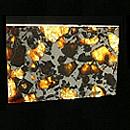|
|
|
|
Click on a letter above to view the list of gems. |
|
|
|
|
|
Pallasite
(variety
of Kamacite; a type of Meteorite) |
|
| Chemistry:
(Fe,Ni)
+ (Mg,Fe2+)2[SiO4]
| |
| Discovered
in 1772;
IMA
status: Kamacite is Valid; Pallasite is Not Valid | ||
|
| ||
|
Classification |
|
|
| |
|
Metals and Intermetallic Alloys | |
|
1/A.07-20 | |
|
|
1 : ELEMENTS (Metals and intermetallic alloys; metalloids and
nonmetals; carbides, silicides, nitrides, phosphides) |
|
Related to: |
Iron - Nickel Group. Iron Series. |
|
|
|
|
Crystal Data |
|
|
|
|
|
Kamacite: Isometric - Hexoctahedral |
|
|
Kamacite: As plates and lamellar masses and in regular intergrowth with taenite. May occur in crystals, to 30 cm; in extended plates and ribbons in Widmanstätten bands. |
|
|
None |
|
|
|
|
|
Physical Properties |
|
|
|
|
|
Indistinct (Kamacite) |
|
|
Hackly, Jagged (Kamacite) |
|
|
Brittle (Kamacite) |
|
|
4.0 (Kamacite) |
|
|
7.90 (g/cm3) (Kamacite) |
|
|
None (Kamacite) |
|
|
Not Radioactive (Kamacite) |
|
|
Other: |
Magnetic (Kamacite) |
|
|
|
|
Optical Properties |
|
|
|
|
|
Steel Gray to Iron Black (Kamacite) |
|
|
Opaque (Kamacite) |
|
|
Metallic (Kamacite) |
|
|
n/a |
|
|
n/a |
|
|
n/a |
|
|
n/a |
|
|
|
|
|
Occurances |
|
|
|
|
|
Geological Setting: |
A major constituent of iron meteorites (siderites) and present in varying amounts in most other meteorites except certain of the stony meteorites (aerolites). |
|
Common Associations: |
Cohenite, Daubréelite, Graphite, Moissanite, Oldhamite, Schreibersite, Taenite, Troilite, other meteorite minerals. |
|
Common Impurities: |
Co, C, P, S |
|
Type Locality: |
Near Krasnojarsk in the mountains of Siberia |
|
Year Discovered: |
1772 |
|
View mineral photos: | |
|
|
|
|
More Information |
|
|
|
|
|
|
Mindat.org
(Kamacite) |
|
|
|
|
Pallasites were once thought to originate at the core-mantle boundary of differentiated asteroids which were subsequently shattered through impacts. An alternative recent hypothesis is that they are impact-generated mixtures of core and mantle materials [Edward R.D. Scott, "Impact Origins for Pallasites," Lunar and Planetary Science XXXVIII, 2007]. Pallasites are often available as polished slices or cabochons with a beautiful contrast between the bright metallic Kamacite and transparent Olivine "windows." Pallasites are among the most beautiful (and expensive) Meteorites and can be found around the world. Pallasites
are named for the German naturalist Peter Simon Pallas
(1741-1811), who located in 1772 an iron specimen with
a mass of 680 kg near Krasnojarsk in the mountains
of Siberia. This meteorite is known as the famous Krasnojarsk
Pallasite. Kamacite is named from the Greek word "kamask"
meaning "shaft" or "lath"
in allusion to its typical crystal pattern. |
|
|
We
have not photographed our Pallasite gems
yet. Please
check back soon. |
